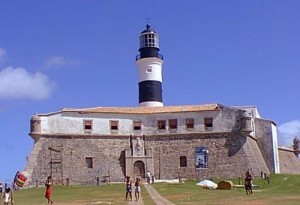Learn about the history of the Galeão Sacramento shipwreck in Salvador and its relationship to the famous Barra lighthouse.
The Shipwreck of the Galeão Sacramento occurred in 1668 off the coast of Salvador, Bahia and is one of the most famous nautical events in the maritime history of colonial Brazil.
Salvador is home to some of the oldest fortifications and lighthouses in the Americas, such as the Forte de Santo Antônio da Barra or Barra Lighthouse, one of the city’s main postcards.
Dating back to 1534, even before the founding of Brazil’s first capital in 1549, what we know today as Farol, da, Barra began as a wooden structure called Forte de Santo Antônio da Barra.

The Lighthouse at Santo Antônio da Barra Fort was built in 1698 in response to the shipwreck of the Galeão Sacramento, a vessel carrying General Francisco Correia da Silva. Correia da Silva, who was to become governor, died in the disaster.
Video – Wreck of the Galeão Sacramento


Instalação do farol no Forte de Santo Antônio da Barra

Naufrágio do Galeão Sacramento em Salvador BA08:16
History of the wreck of the Galeão Sacramento
Leaving the Tagus: The Galeão Sacramento left the Tagus as captain of a fleet of 50 merchant ships belonging to the Companhia Geral do Comércio do Brasil. On board was João Corrêa da Silva and his entourage, destined to take over the government of Bahia.
Shipwreck: Near the Bay of All Saints, the galleon encountered strong winds that made it impossible to manoeuvre, resulting in a collision with the Banco de Santo Antônio. After drifting for about five hours, the galleon sank at 11 pm on 5 May 1668.
Consequences: The tragedy highlighted the urgent need to improve maritime signalling at the entrance to Todos os Santos Bay. Brazil’s growing importance on the trade routes and the consolidation of Salvador as a major South Atlantic port led to the installation of a lighthouse. This lighthouse was initially associated with a fort built by the French.
The shipwreck caused great fear and hastened the decision of the Governor of the Province of Bahia to improve the signalling of the Bar. This event also spurred the construction of forts along the Brazilian coast to protect navigation and trade.
Barra Lighthouse: The popular Barra Lighthouse was built to guide sailors and ensure safety at the entrance to the bay. Today the lighthouse not only serves as a signalling device for boats, but also houses a Nautical Museum. The museum displays archaeological finds from shipwrecks off the coast of Bahia, including items from the Galeão Sacramento, as well as old navigational instruments that illustrate part of Brazil’s maritime history.
Bairro da Barra: The neighbourhood that grew up around the Farol da Barra is one of the most visited and considered aristocratic in Salvador, reflecting the historical and cultural importance of the area.
The sinking of the Galeão Sacramento and the subsequent construction of the lighthouse of Barra are important milestones in the history of navigation and urban development in Salvador.
Bahia.ws – Tourist Guide to Salvador, Bahia and the Northeast
Publicações Relacionadas
History of the Captaincy of Todos os Santos Bay between 1500 and 1697
Pedro Álvares Cabral's expedition and the conquest of Brazil
Portuguese maritime expansion and the conquest of Brazil
Learn about the periods of Brazil's colonial history
Monoculture, Slave Labour and Latifundia in Colonial Brazil
Foundation of the city of São Paulo and the Bandeirantes
Dutch Invasion of Salvador in 1624: Overview
The history of sugar cane in the colonisation of Brazil
Installation of the General Government in Brazil and foundation of Salvador
The History of the Jews in Colonial Brazil
Transfer of the Portuguese court to colonial Brazil
Establishment of the Portuguese colony in Brazil
The Origin of Sugarcane and Sugar Mills in Colonial Brazil
History of the Fortresses and Defences of Salvador de Bahia
Pre-colonial Brazil - The forgotten years
History of the sugar mills of Pernambuco - Beginning and end
The occupation of the African coast and Vasco da Gama's expedition
Sugar Mills in Colonial Brazil: A Historical Insight
This post is also on:
![]() Português
Português ![]() English
English ![]() Deutsch
Deutsch ![]() Español
Español ![]() Français
Français



















